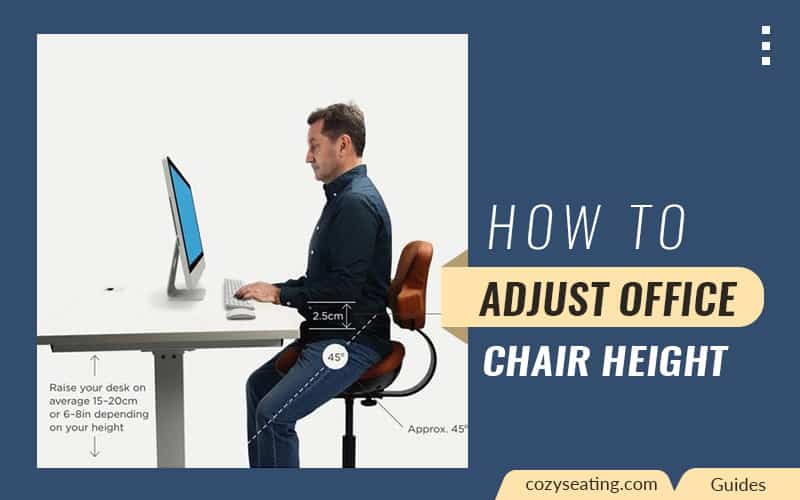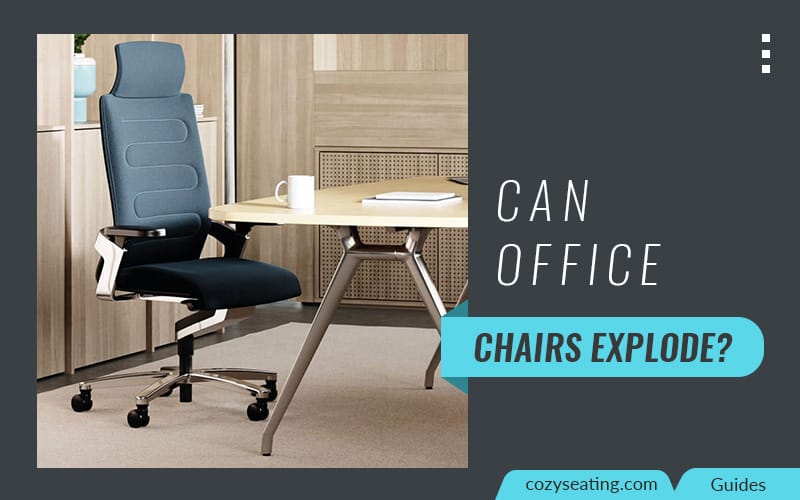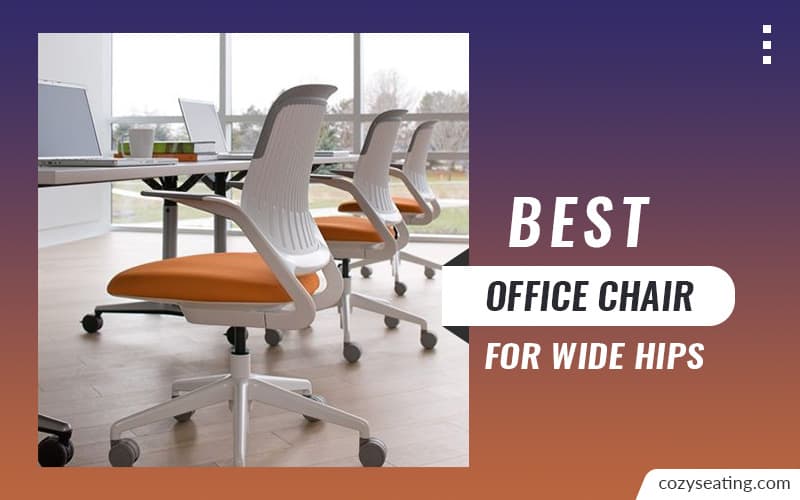
Disclosure: This site is reader-supported & contains affiliate links. We may earn a commission through products purchased using links on this page. Learn more

We benefit immensely from sitting in a good posture, including having better blood flow, ensuring good spinal health, and preventing several body aches. But did you know a good posture may help you digest food better and have a good mood?
Herein, I guide you on how to adjust office chair height and what to do if your chair has height adjustment issues.
You adjust the height of an ergonomic office chair by pulling the right lever up or down. Office chair height adjustment works using the pressure of a compressed fluid on your cylinder’s piston. Also, your office chair should be as high as your knee caps’ base with your elbows at your desk’s height.
Table of Contents
How Do You Adjust the Height of an Ergonomic Chair?
Most office chairs typically have levers located underneath the seat pad. If your office chair has levers, most likely, there are several to control different aspects, including your seat height, angle, and tilt.
Nevertheless, some chairs allow you to adjust your seat height by rotating a knob.
Read your manual if you are unsure which lever or knob controls your office chair’s height. However, you can also turn all the levers or knobs to identify what each of them controls.
Lower and raise your chair’s height until you get what works for you. With most office chairs, the seat lowers and lifts easily upon handling the right lever or knob.
Adjust your seat slowly, working it only through a few centimeters or inches at a time to ensure you get your most suitable working height.
After changing your chair’s height, return the lever to its previous position.
If you are having trouble nailing the right working height for you, alter your seat’s heights while standing. Get in front of your chair and turn the right knob or lever.
How High Should Your Office Chair Be?
Raise and lower your seat’s height such that its tip is as high as the base of your knee caps. This position should be comfortable to work with.
You also want to ensure that you are at eye level with your computer monitor when working. Ensure the screen is just below your eye level with your keyboard at your elbow’s height.
If you can’t alter your monitor’s height, adjust your seat’s height to get a more comfortable position.
Ensure your elbows flush with your table’s height if you are using its flat surface. This position allows you to read files and books, write, or draw with ease. Adjust your chair’s height up or down until you can rest your elbows on the table without straining.
Ensure your feet are resting on the floor if you work for extended periods. It is essential to ensure you sit correctly when in a crucial meeting that may take a while. Adjust your office chair’s height until your feet are flat on your floor to avoid an awkward sitting posture.
Get yourself a footrest if you lack a way to get your feet positioned flat on the floor. Picking an adjustable footrest is a bonus to ensure you sit at the right height, suitable for handling tasks for hours without back and neck pains.
Further reading:
How Does Office Chair Height Adjustment Work?
Some office chairs need you to pull a lever to raise them and push your lever down when lowering them.
Some office chairs use hydraulic cylinder systems, while others use pneumatic ones. Although both use fluids, pneumatic works with gases while hydraulic ones function with liquids. Nevertheless, they have the same mechanical operation.
Pneumatic office chairs allow you to lower or raise your seat’s height by repeatedly pushing it up or down in a pumping action.
When you pull up your chair’s height adjustment lever, it presses a button on its cylinder. A valve opens, releasing a fluid that raises the piston level. Consequently, the piston lifts your office chair’s height, thereby raising it.
Upon releasing the lever or knob, the valve shuts, cutting off the gas or liquid supply. As a result, your office chair stays at its current position.
When pulling down the lever, the valve opens again. This time, you have to add weight to your chair, for example, by sitting. The presence of a load on the chair prevents the piston from carrying the chair, lowering the seat height.
Why Won’t My Chair Go Up and Down?
Your office chair may fail to adjust even after altering your lever’s position due to the lever being faulty or your cylinder not functioning correctly.
If your chair is not moving down, it could be due to a weight issue.
Weight
If your chair fails to lower after adjusting the lever, it could be that you aren’t sitting on it or you are too light. Your cylinder’s piston can lift a particular weight.
When you pull your lever, the valve opens, releasing compressed fluid that acts on the piston leading to rising. If you are light, the force on the piston may be too great to counter, resulting in your chair remaining raised even when you try to lower it.
Try bouncing in your chair as you pull the lever to apply more pressure against the piston and possibly lead to the chair sinking. You can also place something heavy on your lap to increase the force acting against the piston.
Faulty Lever
If you try increasing your weight and the seat fails to lower, your lever may be the issue. Your lever may dislodge or loosen mainly if you use it often. If your lever is loose, it won’t have adequate force to press the valves button.
Tighten a loose lever. A dislodge lever needs repositioning.
How do you go about these fixes?
Begin by detaching your seat from the base. You may need to have a screwdriver to unfasten the bolts.
Once you disassemble your office chair, you should be able to see your cylinder housing. Some office chairs have a casing that goes over the cylinder housing. You’ll need to get rid of that.
Locate a set screw that attaches your height adjustment lever to your seat’s housing. The set screw determines how tight your lever is.
Turn the screw to your left to fasten it to a considerable degree of tightness. Once satisfied, put back your office chair and confirm whether it raises and lowers appropriately.
Learn more: 7 Easy Ways To Raise Your Office Chair Without Lever
Faulty Cylinder
If the first two hacks don’t work for you, your cylinder is likely the issue, and you may need to replace it. So, begin by looking for a suitable replacement.
Ensure your replacement cylinder has the same specifications as your old one to be compatible with your office chair.
Confirm with your chair’s manufacturer as they are likely to have a replacement. You can also remove and carry your old cylinder to the store when seeking a new one. Here is a guide that will help you remove the office chair cylinder.
With your new cylinder ready, you now need to get the necessary equipment to attach it. The things you’ll need include:
- A lubricant, say WD40
- Rubber mallet
- Vice grip or pipe wrench
Steps to Replace the Cylinder
- Overturn your office chair so that it supports itself on the armrests and headrest.
- Use your WD40 to lubricate the place where your chair’s cylinder connects with the housing or base. The longer you allow the lubricant to sit, the less strenuous it is to detach your cylinder from your seat.
- Gently hit the underside of your seat to disengage the cylinder. If it fails to come off, knock it slightly harder. If that still doesn’t work, add more lubricant and let it sit for around another half hour.
- Use your vice grip or pipe wrench to remove your chair’s cylinder from its housing. Position your vice grip as close to the housing’s base to ease your work.
- Fix the replacement by jamming the end of your cylinder into your column and twisting it into position. Take note of any directions your replacement cylinder may come along with.
- Put back your chair and position it upright.
- Check whether the new cylinder allows you to adjust your chair’s height.
Read More:
How to Fix an Office Chair That Won’t Go Up
Frequently Asked Questions
What Is the Best Height for a Chair?
The best height for a chair is between 16 to 25 inches from the ground, which should be okay for most individuals.
This adjustability allows most users to have their feet flat on the ground. Your legs being in the proper position prevents poor blood circulation and your feet from going numb.
How Do I Lower My Office Chair?
You lower your office chair by pulling the lever while sitting on it.
Bump on the chair or carry something on your lap if you are too light to exert adequate pressure to lower your chair.
Final Thoughts
Ensure you change your sitting position every quarter or half an hour to prevent yourself from straining. If you can’t adjust your chair’s height due to your work, try shifting in it.
An example would be to lean forward for a few minutes before supporting yourself on the backrest again.
You could also try shifting your weight in the chair from left to right, and so forth.
Recommended Reading

10 Best Chair For Piriformis Syndrome To Buy in 2022
Are you looking for the best chair for piriformis syndrome? Read through for the best options currently available.

Can Office Chairs Explode?
Is it possible for office chairs to explode? Learn everything you need to know about explosions in office chairs. These facts will blow your mind.

10 Best Office Chair for Wide Hips in 2022
If you have wide hips, you know how hard it can be to find a good office chair. We've reviewed the best office chair for wide hips and found the best options for you.

How to Clean Herman Miller Aeron Chair
Cleaning a Herman Miller Aeron is easy if you use the right tools and products. Learn today by clicking this link how to clean Herman Miller Aeron chair.
